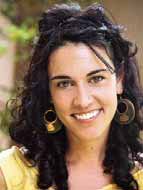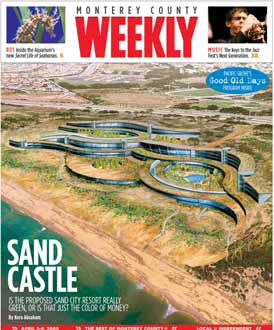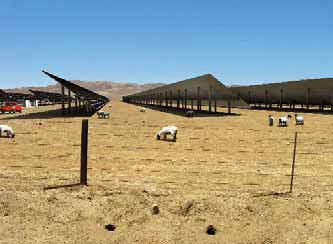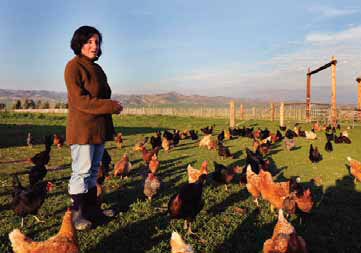SEJournal Online is the digital news magazine of the Society of Environmental Journalists. Learn more about SEJournal Online, including submission, subscription and advertising information.
Inside Story
By BILL DAWSON
 |
|
Kera Abraham. Photo courtesy Kera Abraham.
|
Kera Abraham, assistant editor of the Monterey County Weekly in California, won the first-place honor in the 2010 SEJ Awards for Outstanding Small Market Reporting, Print.
Abraham’s contest entry, comprising three articles, was entitled “Green vs. Green: Environmentalists Duke it Out.” The SEJ judges praised her work this way:
“By examining conflicts in which both sides laid plausible claim to being champions of the environment, Abraham offered an unusually sophisticated and thought-provoking examination of what it means to be green. Her pieces were thoroughly reported, engagingly told, fresh and fair-minded.”
Abraham previously worked at the Eugene Weekly in Oregon, where her job also involved covering environmental issues. She answered emailed questions from SEJournal’s Bill Dawson.
Q: The SEJ contest judges said your three stories “examin[ed] conflicts in which both sides laid plausible claim to being champions of the environment.” Did you set out to find different ways to examine that aspect of environmental politics, even thinking of the articles as an occasional series, or was that common strand more coincidental?
A: The common theme wasn’t planned, but stories that involve clashing shades of green tend to compel me (and my editor) more than predictable conflicts pitting, say, developers against NIMBY neighbors, or polluters against activists.
But even that age-old dynamic is increasingly becoming a green-vs.-green fight. Developers are having more luck getting permits for projects with eco-friendly features. Companies are seeing the profit to be made from products marketed as crunchy and sustainable. In this crappy economy, it seems everyone’s looking for redemptive green qualities in resource-intensive activities that generate money.
So it’s not that I go looking for stories pitting different species of environmentalists against one another. It's more that within the environment beat, it seems sources on all sides are getting better at using green rhetoric.
Q: Are green-vs.-green claims a frequent aspect of environmental controversies in Monterey County and the surrounding areas, or all over California?
A: Yes to both. The California Environmental Quality Act and the California Global Warming Solutions Act, among other laws, ensure every major project proposal is analyzed for its environmental impacts, including greenhouse gas emissions.
 |
|
Award-winning Monterey County Weekly cover story by Assistant Editor Kera Abraham about a planned coastal eco-resort development project that claims it would be the world’s greenest. Photo courtesy Monterey County Weekly.
|
Green-vs.-green squabbles are especially complex along the western border of Monterey County, within the coastal zone, where projects have to pass muster with the California Coastal Commission, and often the Monterey Bay National Marine Sanctuary. In one case, the controversy boils down to whether a big oceanfront “ecoresort” can ever be green enough to build in the face of inevitable sea level rise.
Move to east and south Monterey County and you're in ag country. The environment stories there are about pesticides, oil leases, contaminated farm runoff — complex issues, but less nuanced in terms of who’s on Team Green.
Q: The second of your award-winning articles to be published was about green marketing. It grew out of your coverage of a conference held in Monterey where, you wrote, “a parade of PR wizards” spoke and “employers paid up to $2,595 per head, plus travel expenses, to send people … on a shared assumption: Do-goodery, if marketed right, is profitable.” You also discussed the marketing aspects of two controversial projects — a coastal resort and a huge solar power development — in the other two stories. Is green marketing a coverage subject you were already interested in before these stories? Do you see it as an important subject for environmental journalists to keep in mind as they do their reporting on subjects that aren’t mainly about marketing, per se?
A: One thing about the environment beat is that it seeps into every other one — business, transportation, health care, even sports. Going into journalism, I expected my environmental science degree to equip me to report on the environment. But of course, real-world issues turned out to be much messier than I’d expected. And that made me so much more interested in reporting them.
So yes: I’d say a constant eye on the macro-economy, the political power of industry and the psychological power of marketing is at the heart of the green marketing beat. That means being skeptical of green marketing, but also open to the enormous impacts of industry-wide change.
Q: Your contest entry was titled “Green vs. Green: Environmentalists Duke It Out.” The stories about the resort and solar proposals were long, magazine-style accounts, full of nuance and context and detail. The judges said your stories were “unusually sophisticated … thoroughly reported … fair-minded,” which seemed to me like an excellent description. Nonetheless, these are highly contentious issues. Did you receive much or any criticism or complaint from proponents or opponents of those projects, who thought you weren’t fair or that you should have taken their side? Related to that, do you think environmental politics is a tougher subject to cover in an environmentally-attuned place like Monterey County than it might be someplace that’s not known as being particularly green?
A: Surprisingly, not so much. The solar farm developer and the leader of the opposing citizen group both sent nice notes after the story ran. The “eco-resort” piece got some heated letters from readers on both sides, and a few of the pro-resort sources were slightly chillier in later communications. The organizer of the Sustainable Brands conference remained cheery with me, but made a valid point that one of the companies I’d depicted as genuinely green, Tom’s of Maine, is actually owned by Colgate.
 |
|
Artist's conception of a proposed dual-use solar farm to be developed on existing agricultural land in California’s Panoche Valley, from another award-winning Monterey County Weekly cover story by Assistant Editor Kera Abraham. Photo illustration: Solargen / PV2 Energy.
|
Q: To what extent have you followed up on the resort and solar issues, reporting developments after you did detailed examinations? Has either of them come to a decisive juncture or point of resolution, or are they still being fought out? Generally speaking, how much does your paper — an alternative newsweekly — pay attention to breaking-news developments, whether or not they’re tied to issues you’ve written about in long-form stories? I notice your website has a News Blog. Is this where alot of the breaking stories appear? Is competition with newspapers and broadcast outlets on breaking news an important aspect of your mission?
A: I’ll admit that follow-up can be a challenge as a steady stream of new stories rushes onto my plate. I keep a follow-up reminder list, but it helps when the sources check in. Both the solar farm and the eco-resort controversies are still being fought out, but they haven’t been in the paper lately.
At Monterey County Weekly, we try to stay on top of breaking news within the scope of what we can do with our staff, now up to three news reporters. We prioritize the stories we own — the ones we’re uniquely positioned to tell in a more nuanced, colorful, quirky and/or investigative way than our mainstream competitors.
The News Blog at www.montereycountyweekly.com is for the tapas of the news world, the small bites that don't take long to write: the quick updates, the breaks that won’t hold until our Thursday publication, and sometimes story tangents that had to be cut for space in the paper.
Monterey County Weekly’s mission is “to encourage independent thought and conscious action, etc.” That “etc.” is intentional, and the news team clearly understands it to mean breaking local news — which we do every week.
Q: You’ve worked at the Weekly since January 2007, starting as a staff writer and becoming assistant editor in January 2010. An online profile says your responsibilities include “reporting on five geographical beats, along with environment, oceans and water policy; writing news articles (weekly) and cover stories (about monthly); occasional contributions to arts, culture and opinion sections; spearheading and editing some special issues; assisting with planning and editing [the] weekly news section, including edits on InCopy; posting web stories and updates at montereycountyweekly.com; compiling briefs of web stories for [a] weekly print column; some editing of freelance assignments; [and] proofing of editorial copy.”
That sounds like a lot of work. Um, do you typically work 80-90 hour weeks? Seriously, are all of those duties still on your plate? How do you generally apportion your time? How much of your time is devoted to environmental coverage, would you say? I guess there must be considerable areas of overlap between your environmental and geographical-beat duties?
A: Ha. No, for my first four years at MCW I’d say I averaged about 45-50 hours a week — pulling late-nighters at the office when cover story deadlines loomed, and taking short Thursdays when I felt burnt out. But my baby's birth in late December forced me to take a step back. I just returned from maternity leave in late April, and I’m now working 80 percent time. I still have most of the duties listed above, with the exception of the web story briefs. It’s manageable thanks to the divine coming-together of the paper’s best and biggest news team yet, including a fantastic and very understanding new editor. Having a tiny, amazing person to get home to helps with efficiency.
 |
|
Kim Williams, a small-family egg farmer, is working to preserve California’s Panoche Valley for sustainable agriculture and ecotourism, from another award-winning Monterey County Weekly cover story by Assistant Editor Kera Abraham. Photo by Nic Coury, Monterey County Weekly.
|
I’d say I spend about half my time reporting and writing for the paper, 30 percent editing and proofing, 10 percent writing web stories and 10 percent at meetings. Maybe a little over half my reporting is within the environmental beat, though the borders are fuzzy. Right now, for example, my never-ending assignment is the regional seawater desalination plant, which has an environmental foundation: the illegal over-pumping of the Carmel River is forcing the Monterey Peninsula to find a new water supply. But the day-to-day details involve all that wonky stuff that inevitably gets tied up in a $400-million project.
Q: You previously covered environmental and other subjects for the Eugene Weekly, from 2004-07. Just before that, you earned a master’s degree in magazine journalism from the University of Oregon after getting your undergraduate degree in environmental science at the University of California, Berkeley. Did you initially intend to do science as a career, rather than journalism, or did you pursue the science degree as conscious preparation for becoming a journalist? If you originally thought you'd be a scientist or do something else, other than journalism, when and why did you decide to take the journalistic path?
A: I headed to UC-Berkeley with competing passions for nature and writing. Berkeley didn't offer a journalism undergraduate degree, so I tried English — but got impatient with Chaucer when there was so much to learn about the planet, and how we live on it.
So instead I majored in environmental science, with the intent of using it as background for reporting. But I didn’t know how to break into journalism after I graduated. So, after spending the little money I had bumming around Kauai, I went back to Berkeley and took the first position I was offered, with a company that monitored hazardous waste sites. Turned out that involved being outfitted for a gas mask and spending 10-day stretches taking well-water samples at toxic dumps in the SoCal desert with crusty older male colleagues. The commute was an hour and a half on three buses. I quit six weeks in, started bartending, and applied to J-schools.
A generous fellowship at the University of Oregon took me to Eugene, where I fell in love with the misty redwoods and my future husband. Eugene Weekly hired me right out of the master’s program, and I’ve loved my job ever since.
Q: You were awarded a World Affairs Journalism Fellowship in 2008 by the International Center for Journalists. That allowed you to report on marine life in Chile and Peru, looking for clues about what increasing ocean acidity might mean for fisheries and other marine life off the California coast. Those are issues of keen interest and importance in Monterey County. Please tell me, in summary, what you learned and how the fellowship helped you in your later coverage in California. Any hints for other journalists about how to connect events and trends far away with their reporting at home, even if they never have a fellowship like yours?
A: That two-week “acid trip” reinforced a theme in my local reporting: Most people put themselves, their families and their way of life first. That determines their interactions with the environment.
The scientists I spoke with in Peru and Chile were animated about the data on ocean acidification — but, being scientists, they got dodgy about its real-world implications. The laypeople I met, in contrast, didn’t seem to care much about the chemistry. They wanted to know how it would affect the ceviche.
My story pitch drew on a series of parallels between Monterey Bay and its latitudinal mirror in the Southern Hemisphere. That helped with the narrative arc. But my goal was to illuminate the hugeness of the issue: a subtle but unquantifiably significant change in the world's oceans, which will affect everyone everywhere in ways we can’t predict.
That goes for the Internet, too, which emulsifies information and circulates it around the globe like an electric ocean. Sorry to be so vague in response to your last question, but there it is: Facebook, Twitter, RSS feeds, listservs, YouTube, Skype, SEJ.org.
Bill Dawson is assistant editor of the SEJournal.
* From the quarterly newsletter SEJournal, Summer 2011 issue.












 Advertisement
Advertisement 



